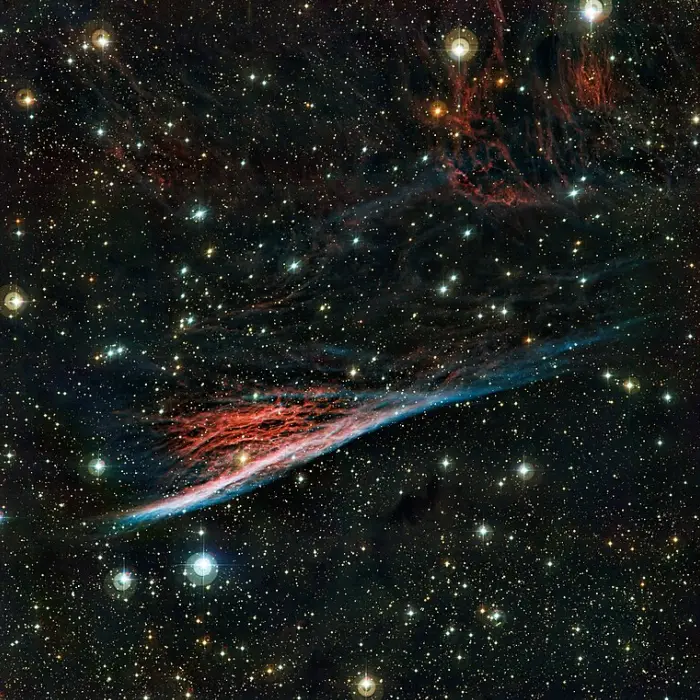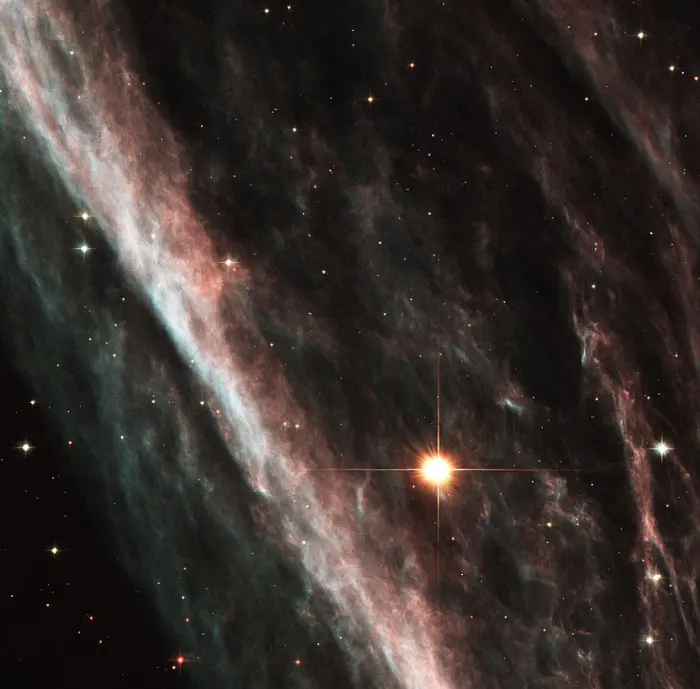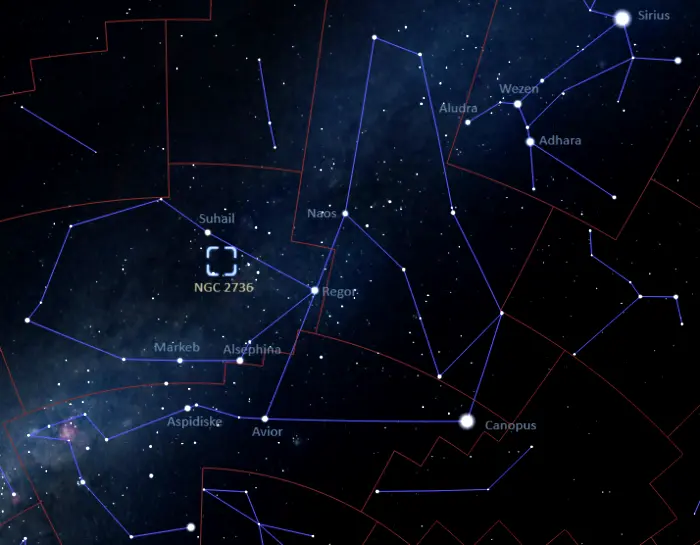The Pencil Nebula is the brightest part of the larger Vela Supernova Remnant, one of the closest supernova remnants to the Sun. The nebula has an apparent magnitude of 12.0 and lies approximately 815 light-years away. It has the designation NGC 2736 in the New General Catalogue.
NGC 2736 was named the Pencil Nebula because of its elongated appearance. It has an apparent size of 30 by 7 arcminutes and a physical radius of 5 light-years.
The nebula is believed to have formed from part of the shock wave of the supernova event that produced the Vela Supernova Remnant. As the shock wave collided with a region of dense gas, it caused it to glow, producing the bright linear nebula that appears like a rippled sheet. The supernova occurred roughly 11,000 years ago.

This strange and beautiful structure is the Pencil Nebula, NGC 2736, a supernova remnant in the constellation of Vela (The Sails). The glowing filaments were created from material ejected in a supernova event that took place about 11 000 years ago. The brightest part resembles a pencil, hence the name, and the whole structure looks a little like a traditional witch’s broom. This picture was captured by the Wide Field Imager on the MPG/ESO 2.2-metre telescope at ESO’s La Silla Observatory in Chile. Image credit: ESO (CC BY 3.0)
The supernova event that produced the remnant would have been visible during the day for several weeks, appearing brighter than any other celestial object except the Sun. At a distance of 936 light-years, the Vela supernova occurred around seven times closer than the historical supernova that produced the better-known Crab Nebula (Messier 1) in the constellation Taurus. The Crab Nebula appears smaller and brighter because it is more distant and has had less time to disperse.
The Pencil Nebula is moving with a velocity of about 644,000 km/h (400,000 mph). Initially, the part of the shock wave that glows as the nebula moved at millions of kilometres per hour, but it has slowed down as it encountered the surrounding interstellar material.
The Pencil Nebula is the brightest portion of the Vela Supernova Remnant, but it is only a small part of the larger stellar debris cloud. The Vela Supernova Remnant is about 8 degrees across, corresponding to a diameter of 100 light-years, and is moving outwards at 1,200 km/s. It is the remnant of a Type II supernova, caused by the core collapse of a massive star.
The stellar remnant left in the wake of the supernova is a neutron star, the Vela Pulsar, that spins 11 times per second. The Pencil Nebula appears around 4.5 degrees west of the Vela Pulsar.
Facts
The Pencil Nebula was discovered by the English astronomer John Herschel from the Cape of Good Hope in South Africa on March 1, 1835. Herschel described the nebula as, “an extraordinary long narrow ray of excessively feeble light (…) At least 20′ long, extending much beyond the limits of the field…” The description gave rise to the nebula’s other nickname, Herschel’s Ray.
The Danish astronomer John Louis Emil Dreyer catalogued the nebula as NGC 2736 in his New General Catalogue of Nebulae and Clusters of Stars (1888). He described it as “a remarkable object, most extremely faint, very large, very very much extended 19°.” Dreyer compiled the New General Catalogue based on the work of William and Caroline Herschel, as well as on John Herschel’s General Catalogue of Nebulae and Clusters of Stars.

Remnants from a star that went out thousands of years ago created a celestial abstract portrait, as captured in this NASA Hubble Space Telescope image of the Pencil Nebula. In this snapshot, astronomers are looking along the edge of the undulating sheet of gas. This view shows large, wispy filamentary structures, smaller bright knots of gas, and patches of diffuse gas. The Hubble Heritage Team used the Advanced Camera for Surveys in October 2002 to observe the nebula. The region of the Pencil Nebula captured in this image is about three fourths of a light-year across. The Vela supernova remnant is 114 light-years (35 parsecs) across. The remnant is about 815 light-years (250 parsecs) away from our solar system. The nebula’s luminous appearance comes from dense gas regions that have been struck by the supernova shock wave. As the shock wave travels through space [from right to left in the image], it rams into interstellar material. Initially the gas is heated to millions of degrees, but then subsequently cools down, emitting the optical light visible in the image.
The colors of the various regions in the nebula yield clues about this cooling process. Some regions are still so hot that the emission is dominated by ionized oxygen atoms, which glow blue in the picture. Other regions have cooled more and are seen emitting red in the image (cooler hydrogen atoms). In this situation, color shows the temperature of the gas. The nebula is visible in this image because it is glowing. Image credit: NASA and The Hubble Heritage Team (STScI/AURA); Acknowledgment: W. Blair (JHU) and D. Malin (David Malin Images) (PD)
Location
The Pencil Nebula lies in the southern constellation Vela. At declination – 46°, it is visible from locations south of the latitude 44° N. However, it never rises very high above the horizon for observers in the mid-northern latitudes.
The nebula appears within a triangle formed by Regor (Gamma2 Velorum), Alsephina (Delta Velorum), and Suhail (Lambda Velorum), the three brightest stars in Vela. The nebula is found about 3 degrees south-southwest of Suhail.
The three Vela stars can be identified using the False Cross, an asterism formed by Alsephina and Markeb in Vela with Avior and Aspidiske in the neighbouring Carina. Suhail and the Pencil Nebula lie close to the imaginary line extended from Avior through Alsephina.

The location of the Pencil Nebula (NGC 2736), image: Stellarium
The best time of the year to observe the Pencil Nebula and other deep sky objects in Vela is during the month of March, when the constellation appears higher above the horizon in the early evening.
Pencil Nebula – NGC 2736
| Constellation | Vela |
| Object type | HII region |
| Right ascension | 09h 00m 12.0s |
| Declination | −45° 57′ 00″ |
| Apparent magnitude | 12.0 |
| Apparent size | 30’ x 7’ |
| Distance | 815 light-years (250 parsecs) |
| Radius | 5 light-years |
| Names and designations | Pencil Nebula, NGC 2736, RCW 37, GRS G267.00 +00.10 |